Florentine Truher-Lietzau family origins, out of Europe
• Emerging investigation as to Truher European emigrant origins.
Much of what follows is based on a brief conversation with a niece of Pat Schonborg, a distant Truher-Lietzau cousin. Remember Florentine Truher-Lietzau was married first to Martin Truher with whom she had two sons; then Florentine married a Mr. Lietzau with other children. All this in Germany. Florentine's sons emigrated to America in late 1870s. These last village in Europe is not confirmed,. My best guess about their last point of origin is Koscierzynak (German name: Berent).

same url: http://www.koscierzyna.gda.pl/eng/
Here are some possible village origins, currently being re-evaluated) from this region of West Prussia, southwest of Danzig, Pomerania, etc.
1. PLAESCHEN
2. BUKOVITZ, BUKOWWITZIEC
3. PORORESKIE
4. KOSCIERZYNA (BERENT)
German records were largely destroyed by the Poles after WWII, but there is also reconstruction or removal of records to East German territory organizations.
We even have located an 18th century Susanna Truher, but no confirmation of our blood line.
https://gene.truher.net/truher/Susanna/LDS-SusannaTruher3.jpg
https://gene.truher.net/truher/Susanna/SusannaTruher-Year1713Chemnitz.jpg
We have other indications that the Florentine Truher-Lietzau people were from much farther south - Lietzau near Leipzig. Florentine herself said she was from just south of Berlin, according to Ron Haack's tape with Augusta Truher Haack's daughter.
Wherever they came from in the particular, these people were Saxon stock - the same who invaded England and left their mark there, long before they invaded America to Minnesota, leaving California with us.
Much of what follows is based on a brief conversation with a niece of Pat Schonborg, a distant Truher-Lietzau cousin. Remember Florentine Truher-Lietzau was married first to Martin Truher with whom she had two sons; then Florentine married a Mr. Lietzau with other children. All this in Germany. Florentine's sons emigrated to America in late 1870s. These last village in Europe is not confirmed,. My best guess about their last point of origin is Koscierzynak (German name: Berent).

same url: http://www.koscierzyna.gda.pl/eng/
Here are some possible village origins, currently being re-evaluated) from this region of West Prussia, southwest of Danzig, Pomerania, etc.
1. PLAESCHEN
2. BUKOVITZ, BUKOWWITZIEC
3. PORORESKIE
4. KOSCIERZYNA (BERENT)
German records were largely destroyed by the Poles after WWII, but there is also reconstruction or removal of records to East German territory organizations.
We even have located an 18th century Susanna Truher, but no confirmation of our blood line.
https://gene.truher.net/truher/Susanna/LDS-SusannaTruher3.jpg
https://gene.truher.net/truher/Susanna/SusannaTruher-Year1713Chemnitz.jpg
We have other indications that the Florentine Truher-Lietzau people were from much farther south - Lietzau near Leipzig. Florentine herself said she was from just south of Berlin, according to Ron Haack's tape with Augusta Truher Haack's daughter.
Wherever they came from in the particular, these people were Saxon stock - the same who invaded England and left their mark there, long before they invaded America to Minnesota, leaving California with us.
• See Caroline Pein Truher (Gottlieb's wife) on right of next photo, apparently acting as caterer to wealthy family, or perhaps serving at large family reception.
https://gene.truher.net/truher/GottliebCaroline/CarolinePeinTruher-wRelatives.jpg
First home of August and Nellie Truher,
https://gene.truher.net//truher/August/_ta001-1903HomeAugustusTruher.jpg
Marriage Certificate, Austin, Minnesota,
https://gene.truher.net//truher/August/_ta002-AugustNellieTruher-Married-cropped.jpg
Jack with grandfather August Truher,
https://gene.truher.net/truher/August/_ta003-Augustus-John.jpg
August left the Lutheran Church to marry Catholic Nellie,
https://gene.truher.net/truher/August/_ta005-ChurchOfStAugustine.jpg
grandmother Nellie Truher with Jack and Jim,
https://gene.truher.net/truher/August/_ta006-NellieWilderJamesJohn.jpg
https://gene.truher.net/truher/GottliebCaroline/CarolinePeinTruher-wRelatives.jpg
First home of August and Nellie Truher,
https://gene.truher.net//truher/August/_ta001-1903HomeAugustusTruher.jpg
Marriage Certificate, Austin, Minnesota,
https://gene.truher.net//truher/August/_ta002-AugustNellieTruher-Married-cropped.jpg
Jack with grandfather August Truher,
https://gene.truher.net/truher/August/_ta003-Augustus-John.jpg
August left the Lutheran Church to marry Catholic Nellie,
https://gene.truher.net/truher/August/_ta005-ChurchOfStAugustine.jpg
grandmother Nellie Truher with Jack and Jim,
https://gene.truher.net/truher/August/_ta006-NellieWilderJamesJohn.jpg
• We are hoping to establish place of origin for Truher-Lietzau somewhere near Danzig, now Poland.
Jack wrote to Ron, mid-February 2005 10:38 PM
DID YOU GET Johann Lietzau Jr.'s MARRIAGE AND CHILDREN DATA FROM PAT SCHONBORG'S DATA BASE OR FROM YOUR OWN RESEARCH EARLY OR LATELY? SOMETHING NEW FROM THERE WOULD BE EUREKA FOR SURE.
I am not so sure that it was MY data. I looked up the data area of my Family Tree Maker and I show NO notes, or ANY sources, not typical if it was MY data;however, ALL entries are in the form of "Name" whereas anything from Pat Schonborg would have been "NAME" (all capitals, a sure signature of HER origin). I need to review my 25 year old hand written notes. At the time I was researching at St. Lucas Church in Milwaukee, I had no idea that Lietzau was so important, I simply noticed Caroline Pein Truher at Caroline Lietzau's wedding, and at least copied everything I could find.
--------------------------------------
Ron continued later:
Date: Wed, 16 Feb 2005 00:37:26 -0500
I have been examining (ransacking) my files all evening. I have found my original Saint Lucas Church notes, along with a 1978 letter that I sent to Pat Schonborg. Pat Schonborg also sent some tree charts to me in 2000, and one of my letters to her indicated I still had not entered all my family stuff into my computer as of 1999.
The data in my Family Tree Maker for siblings Johann Lietzau Jr. and Caroline Lietzau, and some other areas, was a partial entry typed in by ME from PAT's snail mail charts. It is incomplete, and so I must go MAKE it complete from her paper charts;however, my notes from Saint Lucas Church show that, verbatim:
"Bay View, Wisconsin - St. Lucas Lutheran Church. Baptized was Emilie Litzow, born 28 October, 1875, baptized 30 October 1875. Parents: Johann Litzow and Amalie nee Burant. godparents: Gottlieb and Caroline Truher."
Soooooo, our Lietzau family DID start out in Bay View (Milwaukee) Wisconsin, along with our Truher family, and all in the same church. Now, I show by Pats paper trees that Johann Lietzau had descendants (which are not yet in my computer) that ended up in northern Minnesota, blended into the Pinske line (ASIDE from Caroline Lietzau marrying into the Pinske line), AND THAT I MET SOME OF THEM, HAVE PHONE NUMBERS, ETC. AND NEVER KNEW IT! he,he, now I REALLY have some telephone calls to make!
Jack wrote to Ron, mid-February 2005 10:38 PM
DID YOU GET Johann Lietzau Jr.'s MARRIAGE AND CHILDREN DATA FROM PAT SCHONBORG'S DATA BASE OR FROM YOUR OWN RESEARCH EARLY OR LATELY? SOMETHING NEW FROM THERE WOULD BE EUREKA FOR SURE.
I am not so sure that it was MY data. I looked up the data area of my Family Tree Maker and I show NO notes, or ANY sources, not typical if it was MY data;however, ALL entries are in the form of "Name" whereas anything from Pat Schonborg would have been "NAME" (all capitals, a sure signature of HER origin). I need to review my 25 year old hand written notes. At the time I was researching at St. Lucas Church in Milwaukee, I had no idea that Lietzau was so important, I simply noticed Caroline Pein Truher at Caroline Lietzau's wedding, and at least copied everything I could find.
--------------------------------------
Ron continued later:
Date: Wed, 16 Feb 2005 00:37:26 -0500
I have been examining (ransacking) my files all evening. I have found my original Saint Lucas Church notes, along with a 1978 letter that I sent to Pat Schonborg. Pat Schonborg also sent some tree charts to me in 2000, and one of my letters to her indicated I still had not entered all my family stuff into my computer as of 1999.
The data in my Family Tree Maker for siblings Johann Lietzau Jr. and Caroline Lietzau, and some other areas, was a partial entry typed in by ME from PAT's snail mail charts. It is incomplete, and so I must go MAKE it complete from her paper charts;however, my notes from Saint Lucas Church show that, verbatim:
"Bay View, Wisconsin - St. Lucas Lutheran Church. Baptized was Emilie Litzow, born 28 October, 1875, baptized 30 October 1875. Parents: Johann Litzow and Amalie nee Burant. godparents: Gottlieb and Caroline Truher."
Soooooo, our Lietzau family DID start out in Bay View (Milwaukee) Wisconsin, along with our Truher family, and all in the same church. Now, I show by Pats paper trees that Johann Lietzau had descendants (which are not yet in my computer) that ended up in northern Minnesota, blended into the Pinske line (ASIDE from Caroline Lietzau marrying into the Pinske line), AND THAT I MET SOME OF THEM, HAVE PHONE NUMBERS, ETC. AND NEVER KNEW IT! he,he, now I REALLY have some telephone calls to make!
• But where did they come from? Start at Berent (Gr) = Koscierzyna (Polish)
https://peacework.us./gene2/Truher-Lietzau-Koscierzyna/
I have found a way that I think is just as good, and it can be done at your local LDS genealogical center. Recall I have told you about a likely place of origin for Truher and Lietzau surnames: in German Berent, otherwise known as Koscierzyna in Poland, about 50 kM southeast of Danzig.
http://en.wikipedia.org/wiki/Ko%C5%9Bcierzyna
Recall some confirmation in our investigation with the Kashubians of Milwaukee recent.
The German Church records are available with the LDS libraries everywhere on microfilm from Koscierzyna.
Follow the wikipedia link above to find these records. The first is Catholic, not likely Gottlieb's people.
Title
Kirchenbuch, 1642-1906
Authors
Katholische Kirche Berent (KrSt. Berent) (Main Author)
Notes
Mikrofilme aufgenommen von Manuskripten in Berlin-Dahlem, im Katholischen Kirchenbuchamt München und im Geheimen Staatsarchiv Berlin-Dahlem.
Parish register of baptisms, marriages and deaths for Berent (AG. Berent), Westpreußen, Preußen, Germany, now Kóscierzyna (Kościer zyna), Gdańsk, Poland.
Subjects
Germany, Preußen, Westpreußen, Berent - Church records
Poland, Gdańsk, Kościerzyna (Kościerzyna) - Church records
Format
Manuscript (On Film)
Language
German
Publication
Salt Lake City, Utah : Gefilmt durch The Genealogical Society of Utah, 1950, 1965, 1974
Berlin-Dahlem : Geheimes Staatsarchiv
Physical
auf 13 Mikrofilmrollen ; 35 mm.
the German link for Berent: then is:
Topic Details
Topic
Germany, Preußen, Westpreußen, Berent - Church records
Title search results
Kirchenbuch, 1642-1906 Katholische Kirche Berent (KrSt. Berent)
Kirchenbuch, 1781-1944 Evangelische Kirche Berent (KrSt. Berent)
2 matching titles.
There must be people who would chase that down. I'm in no condition to get involved, certainly not in the near term.
recall I did some research on Koscierzyna recently,
https://peacework.us./gene2/Truher-Lietzau-Koscierzyna/
also now at
https://gene.truher.net/truher/Koscierzyna-Truher-Lietzau/
and something on the Kashubians, in our email exchanges about Jakob, Gottlieb
at their intersecting the Kashubians on Jones Island at the Terminus of rivers in Milwaukee.
We have been calling them Kaszubians, probably the Americanization.
https://peacework.us./gene2/Truher-Lietzau-Koscierzyna/
I have found a way that I think is just as good, and it can be done at your local LDS genealogical center. Recall I have told you about a likely place of origin for Truher and Lietzau surnames: in German Berent, otherwise known as Koscierzyna in Poland, about 50 kM southeast of Danzig.
http://en.wikipedia.org/wiki/Ko%C5%9Bcierzyna
Recall some confirmation in our investigation with the Kashubians of Milwaukee recent.
The German Church records are available with the LDS libraries everywhere on microfilm from Koscierzyna.
Follow the wikipedia link above to find these records. The first is Catholic, not likely Gottlieb's people.
Title
Kirchenbuch, 1642-1906
Authors
Katholische Kirche Berent (KrSt. Berent) (Main Author)
Notes
Mikrofilme aufgenommen von Manuskripten in Berlin-Dahlem, im Katholischen Kirchenbuchamt München und im Geheimen Staatsarchiv Berlin-Dahlem.
Parish register of baptisms, marriages and deaths for Berent (AG. Berent), Westpreußen, Preußen, Germany, now Kóscierzyna (Kościer zyna), Gdańsk, Poland.
Subjects
Germany, Preußen, Westpreußen, Berent - Church records
Poland, Gdańsk, Kościerzyna (Kościerzyna) - Church records
Format
Manuscript (On Film)
Language
German
Publication
Salt Lake City, Utah : Gefilmt durch The Genealogical Society of Utah, 1950, 1965, 1974
Berlin-Dahlem : Geheimes Staatsarchiv
Physical
auf 13 Mikrofilmrollen ; 35 mm.
the German link for Berent: then is:
Topic Details
Topic
Germany, Preußen, Westpreußen, Berent - Church records
Title search results
Kirchenbuch, 1642-1906 Katholische Kirche Berent (KrSt. Berent)
Kirchenbuch, 1781-1944 Evangelische Kirche Berent (KrSt. Berent)
2 matching titles.
There must be people who would chase that down. I'm in no condition to get involved, certainly not in the near term.
recall I did some research on Koscierzyna recently,
https://peacework.us./gene2/Truher-Lietzau-Koscierzyna/
also now at
https://gene.truher.net/truher/Koscierzyna-Truher-Lietzau/
and something on the Kashubians, in our email exchanges about Jakob, Gottlieb
at their intersecting the Kashubians on Jones Island at the Terminus of rivers in Milwaukee.
We have been calling them Kaszubians, probably the Americanization.
• Truher-Lietzau-Schafferius-Kashubians.rtfd
Schafferius Family Update
Travel in Steerage, 19th Century
Up to the second half of the nineteenth century, the transport of emigrants was only a subsidiary branch of cargo transport, and emigrants consequently travelled in cargo ships temporarily adapted for passengers.
A deck was built between the upper deck and the hold--in German this was known as Zwischendeck. Steerage was primitive. The berths were removed again at the end of the voyage since the space was needed on the return journey for cargo. They were knocked together out of mere planks, narrow and mostly too short.
Mattresses and bedding were provided by the passengers. There were few latrines and ventilation was poor. All the passengers were crowded into this poorly-lit deck both day and night. Only if the weather was good was it possible for them to emerge onto the upper deck.
Medical care was not available. Passengers provided their own food and crockery. (They were provided with water.) For cooking there was a fireplace or two, insufficient--this problem often led to quarrels between passengers and many went for days without a hot meal.
By about the end of the 1870s, the steamship had replaced the sailing ship which improved conditions almost at once. The passage (to the USA) was reduced to seventeen days--compared to the sailing vessel's ninety days. Fast steamers in the 1890s made the crossing in nine days. These were fitted especially for passengers and were better ventilated, had doctors, had privacy for women, and food was more plentiful.
as found in http://www.myfamily.com
for the Schafferius Family Update.
Jack found this Australian family interesting, because of similarity in Schafferius
with a nearly identical spelling in the Truher family line. Also in my previous searches,
I found many of the same place of origin names, from whence I learned from the
Los Altos Lietzau descendent. The towns southeast of, and near Danzig which commonly appear in the stories of Truher-Lietzau and Schafferius-Lietza are:
Berent or Koscierzyna, and perhaps Pinczyn. Notice also in the related Colston & Wenck Generalogy that Karl Ferdinand Lietzau is said to hail from Berent (Koscierzyna) Germany, also identified as Kashubian/Pomeranian in Poland.
A Kashubian connection is another suggestive linkage as we learned in the story of Gottlieb Truher, which Jack told in the link:



http://colston-wenck.com/getperson.php?personID=I473&tree=colstonwenck
KOSCIERZYNA IS 600 YEARS OLD: 1398 – 1998
German troops marched into town on 2 September 1939, and Hitler’s first victims included national activists, men of education and the clergy. The town did not passively surrender to the exterminators but fought back, and carried on fighting until the day of liberation. The first underground movement was a branch of the Polish Home Army organized by Jan Landowski. Another rebel force was the Gryf Pomorski (Pomeranian Griffin) Secret Military Organization. Numerous plaques and monuments in the town commemorate the heroes of those days.
Koscierzyna’s oldest monument is the well-preserved nineteenth century town centre with a unique market square. The four corners of the square are the departure points of two streets which each run at square angles to the square itself. The atmosphere of the small nineteenth century town is still present here. The fourteenth century plan of the town’s centre is still evident, although, due to the ravages of numerous fires, the oldest buildings date to the eighteenth century. A two-storied town hall built in 1843, with its distinctive clock on top, is the oldest building in the market square. Most of the residential buildings on the market square and the adjacent streets were built at the turn of the nineteenth century. The eighteenth century structures are represented by two interesting buildings: a house on Koscielna Street that belonged to the well-known town potters, the Budzynski family, and a residential building on Dluga Street. The seat of the local court is a fine example of old Neo-Gothic architecture.
Monuments of sacral art include the Neo-Baroque Holy Trinity parish church, built in 1914 – 1917, which replaced an older, smaller brick church. Its interior has retained its baroque and rococo character thanks to altars, a baptismal font and a pulpit salvaged from other churches which had been destroyed in fires. The church is the sanctuary of the Virgin Mary of Koscierzyna. Since the end of the seventeenth century, annual pilgrimages to the Wejherowo Calvary have begun from here. In the chapel next to the Neo-Gothic Angelic Virgin Mary convent school there is a pietà, a fifteenth century masterpiece of Pomeranian mason-work. The slender spire of the once Evangelical church and today a Catholic convent sanctuary towers over the area. The structure’s interior design, especially an admirable palm vault, altars and sculptures, are all the work of Koscierzyna’s famous sculptor Franciszek Greinke. The nineteenth century sacral structures include the Neo-Romanesque St. Barbara cemetery chapel from the 1880s, which replaced the eighteenth century church.
Koscierzyna’s necropolis is the final resting place for the ashes of the Kashubian region’s most worthy sons. Tomasz Rogala was a shoemaker by profession, but he was also a member of many patriotic societies and an organizer of workers’ meetings and the school strike of 1906. Rogala, referred to as the Kashubian King, made himself famous for his patriotic speech defending the Kashubian region at the Versailles peace conference. Lubomir Szopinski was a talented and devoted Koscierzyna-born composer and conductor and the founder of the Kashubian choir which subsequently grew into the Song and Dance Band of Kashubia. Another man of great local renown was Leon Heyke, a priest and folklorist, as well as a talented author of dramatized stage anecdotes often performed in Kashubia. His greatest achievement as a poet, however, is Piesnie Polnocy (Songs from the North) in the volume entitled Kszëbszcie spiewë. Primary School No. 2 bears his name in commemoration of his merits.
The group of regional celebrities also includes Aleksander Majkowski - a doctor, a poet, a regional activist and the founder of the Young Kashubia movement. He fought not only against the Germanization of Kashubia but also against provincial parochialism. He worked for previously existing organizations and set up new ones, such as the People’s Reading-Rooms Society or the Kashubian House. He initiated the publishing of the Gryf (The Griffin) magazine which addressed Kashubian matters. He struggled to awaken Kashubian awareness among the local people. He wrote: “My Kashubian brothers, be yourselves!”. A commemorative bust of Majkowski has been placed at the foot of the old castle hill.
Kashubia was also a birthplace of Jozef Wybicki, the author of the Polish national anthem. There is a monument in his honour in one of Koscierzyna’s main streets. Today, the National Anthem Museum is located in Bedomin (east of Koscierzyna) in the old manor-house where Wybicki was born on 29 September 1747. This replaced the Wybicki Commemorative Chamber in 1978 thanks to the efforts of the Kashubian and Pomeranian Association.
===========================================
source for text above has been lost
but check this out http://en.wikipedia.org/wiki/Ko%C5%9Bcierzyna
leads to German language sources:
http://www.familysearch.org/Eng/Library/fhlcatalog/supermainframeset.asp?display=titledetails&titleno=300730&disp=Kirchenbuch%20%20&columns=*,0,0
============================================
History of the land of the Kashubs
http://en.kaszubia.com/kashubians/history/kashubs_history
Tags: Kashubians
History of Cassubia is lengthy and interesting. The Kashubs have lived in Pomerania for over a thousand years, but their written history begins as late as 1238 AD. Pope Gregor IX called then the Stettinian prince Bogusław “the prince of Cassubia”. It is the oldest document known that mentions Cassubia, by which is understood the Western Pomeranian principality that existed from the 12th to 16th century and reclined to German political influences and military power.
In Eastern Pomerania since the end of the 12th century also existed an independent principality ruled by Subisław and his progeny. The most famous of them was Świętopełk who ruled the Gedanian Pomerania in years 1219-1266. His son Mściwój II ruled the land since 1271, unfortunately he had no successor. In 1282, he bequeathed his land to the Posnanian prince Przemysław II. When he died in 1294, Cassubia entered into a union with Poland and Przemysław was crowned a king of the newly augmented kingdom. At the beginning of 1296, he was assassinated though and his land invaded by the neighbors. Following that, in Cassubia began a long period of the Teutonic Knights’, intertwined with the Polish rule that lasted (with breaks) until the partitions of Poland (1772-1796). Then, for over 120 years, Kashubian land remained under the rule of Prussia. In 1920, it was taken over by Poland to which, less the Second World War years, it still belongs.
The Kashubs are a Slavonic nation most closely related to the Poles. Their language, Kashubian, belongs to the group of Slavonic languages and consequently resembles Polish, Russian and Czech. Because of the lengthy German neighborhood, Kashubian has incorporated many words derived from the Germanic languages, mainly German, but Kashubian grammar closely resembles that of Polish. The Kashubs pronounce some words in a manner similar to Poles, but use more vowels. Kashubian contains multiple dialects and a different variation of the language is spoken by the sea, in the area around Wejherowo, Kartuzy, or in the Tucholian Forests that form the southern border of Cassubia.
For many years Kashubs displayed a frail sense of their national identity, culture and language. Inadequate education, poverty, illiteracy, and German oppression afforded the latter decisive dominance in the area. The Kashubs were treated as the second-class citizens; a nation of a lower rank. At times they have endorsed similar attitudes themselves frequently showing no desire to change their dim fate. They could not imagine the world beyond their limited confines, as their rational horizons were rather narrow.
The first to recognize the distinctiveness of the Kashubian folk from their neighbors was Florian Ceynowa. He is known as the “Awakener of the Kashubs”. He has learned the Kashubian language, tried to collect its vocabulary and define its spelling. Active in the second half of the 19th century, he wrote and kept publishing short Kashubian stories along with scientific works. Unfortunately, he failed to “wake up” the Kashubs, became tired of the job and for the rest of his life worked as a physician. He died in 1881.
But soon the cultural level of Cassubia rose and the first Kashubian books appeared. The most famous of them was “O panu Czorlińsczim co do Pucka po sece jachôł” (About Mr. Czorlińsczi who went to Puck to buy the fishing nets) by Hieronim Derdowski. Its author also was a Kashubian activist who lived toward the end of the 19th century later immigrating to America where he kept publishing a popular magazine for American Poles called “Wiarus” (The Veteran). He died in 1902, aged 50.
Near the end of the century a Kashubian activist, Aleksander Majkowski, soon realized that he would not accomplish much working alone. Therefore he formed an organization dedicated to Kashubian matters which he called Towarzystwo Młodokaszubów (Society of Young Kashubs). It was active between 1912 and the start of the First World War. Its successes were rather few and far between but it has initiated collaboration of Kashubian activists. Majkowski himself continued to be active after the war later turning to literary works. Amongst others he wrote the greatest Kashubian novel “Żëcé i przigodë Remusa” (Life and Adventures of Remus) and a draft of the history of the Kashubs. He died in 1938.
Towards the end of his life Majkowski became a dedicated supporter of the young Kashubian activists who in 1929 formed Zrzeszenie Regionalne Kaszubów (Kashubian Regional Union). It incorporated Aleksander Labuda, Jan Trepczyk, Stefan Bieszk, Jan Rompski, Feliks Marszałkowski, and Rev. Franciszek Grucza. They published the “Zrzesz Kaszëbskô” (Kashubian Union) magazine and tried to enliven and alleviate the Kashubian culture and activity. Although they met with obstacles on the part of the Polish pre-war authorities and other regional circles and institutions, they managed to do a lot for the promotion of the Kashubian language and literature. Very well known are Labuda’s short stories (editorials ), Trepczyk’s songs, as well as the Kashubian translation of “The New Testament” authored by Rev. Grucza.
During the war the Kashubs lived under the German terror. Many were treated as Germans and forcibly enlisted into the Hitlerian army as cannon fodders. Thousands of inhabitants of this land were killed in public executions, in combat or Nazi concentration camps. Amongst them were Kashubian activists, e.g. Rev. Leon Heyke, bishop Konstantyn Dominik, the Mayor of Wejherowo Teodor Bolduan, or teacher Stefan Lewiński. In Cassubia throughout the war an underground organization „Gryf Pomorski” (Pomeranian Griffon) performed its anti-German actions.
After the liberation a verification of the Kashubs fighting in the Third Reich army was ordered alongside the rehabilitation of people who more or less voluntarily declared themselves as Germans during the war in this part of Poland. A feeling of mistrust to Kashubs came prevalent within the Polish authorities and lasted for many years.
At the end of 1956, a group of Kashubian intellectuals managed to set up a local organization called Zrzeszenie Kaszubskie (Kashubian Association) that later renamed itself to Zrzeszenie Kaszubsko-Pomorskie (Kashubian-Pomeranian Association). From the word go it has tried to take care of the Kashubian language and culture, document the history of the area, collect and protect the Kashubian folklore, inspire and create Kashubian literature and in many ways „wake” the Kashubs. The Association counts a few thousand members, conducts many actions and leads several institutions, while publishing numerous books devoted to Kashubian matters. Recently it launched the issuance of a three-volume publication entitled “The History of the Kashubs” whose first volume has already been released and written by Prof. Gerard Labuda, the best known of all living Kashubs in the world.
==========================
http://en.kaszubia.com/kashubians/history/maps
Maps – Kashubia Throughout History
Tags: Kashubia , Kashubians , Pomerania , Pomeranians
Kashubia Throughout History
The presented maps are based on research of Prof. Dr Józef Borzyszkowski as published in his book “Historia Kaszubów” [en. History of Kashubians], Gdańsk 1999. They also reflect studies conducted by Dr Jan Modrawski as published in “Geografia współczesnych Kaszub” [en. Geography of Contemporary Kashubia], Gdańsk 1999.
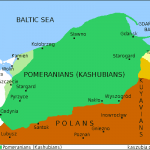
Pomeranians (Kashubians) between 800-950, A.D.
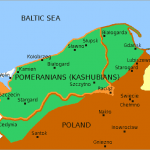
Pomeranians (Kashubians) around 925, A.D.
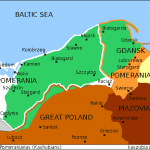
Pomeranians (Kashubians) around 1180
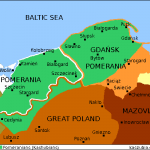
Pomeranians (Kashubians) around 1220
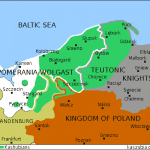
Kashubians around 1370
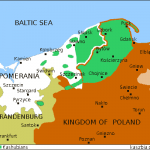
Kashubians around 1640
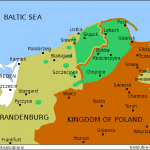
Kashubians around 1660
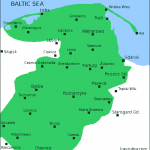
Kashubians in 19th century
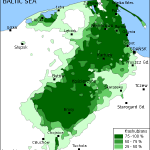
Kashubians 19th/20th century
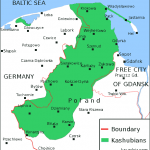
Kashubians between 1918-1939
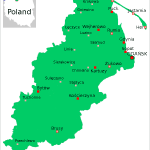
Kashubians in 20th century
Schafferius Family Update
Travel in Steerage, 19th Century
Up to the second half of the nineteenth century, the transport of emigrants was only a subsidiary branch of cargo transport, and emigrants consequently travelled in cargo ships temporarily adapted for passengers.
A deck was built between the upper deck and the hold--in German this was known as Zwischendeck. Steerage was primitive. The berths were removed again at the end of the voyage since the space was needed on the return journey for cargo. They were knocked together out of mere planks, narrow and mostly too short.
Mattresses and bedding were provided by the passengers. There were few latrines and ventilation was poor. All the passengers were crowded into this poorly-lit deck both day and night. Only if the weather was good was it possible for them to emerge onto the upper deck.
Medical care was not available. Passengers provided their own food and crockery. (They were provided with water.) For cooking there was a fireplace or two, insufficient--this problem often led to quarrels between passengers and many went for days without a hot meal.
By about the end of the 1870s, the steamship had replaced the sailing ship which improved conditions almost at once. The passage (to the USA) was reduced to seventeen days--compared to the sailing vessel's ninety days. Fast steamers in the 1890s made the crossing in nine days. These were fitted especially for passengers and were better ventilated, had doctors, had privacy for women, and food was more plentiful.
as found in http://www.myfamily.com
for the Schafferius Family Update.
Jack found this Australian family interesting, because of similarity in Schafferius
with a nearly identical spelling in the Truher family line. Also in my previous searches,
I found many of the same place of origin names, from whence I learned from the
Los Altos Lietzau descendent. The towns southeast of, and near Danzig which commonly appear in the stories of Truher-Lietzau and Schafferius-Lietza are:
Berent or Koscierzyna, and perhaps Pinczyn. Notice also in the related Colston & Wenck Generalogy that Karl Ferdinand Lietzau is said to hail from Berent (Koscierzyna) Germany, also identified as Kashubian/Pomeranian in Poland.
A Kashubian connection is another suggestive linkage as we learned in the story of Gottlieb Truher, which Jack told in the link:



http://colston-wenck.com/getperson.php?personID=I473&tree=colstonwenck
KOSCIERZYNA IS 600 YEARS OLD: 1398 – 1998
German troops marched into town on 2 September 1939, and Hitler’s first victims included national activists, men of education and the clergy. The town did not passively surrender to the exterminators but fought back, and carried on fighting until the day of liberation. The first underground movement was a branch of the Polish Home Army organized by Jan Landowski. Another rebel force was the Gryf Pomorski (Pomeranian Griffin) Secret Military Organization. Numerous plaques and monuments in the town commemorate the heroes of those days.
Koscierzyna’s oldest monument is the well-preserved nineteenth century town centre with a unique market square. The four corners of the square are the departure points of two streets which each run at square angles to the square itself. The atmosphere of the small nineteenth century town is still present here. The fourteenth century plan of the town’s centre is still evident, although, due to the ravages of numerous fires, the oldest buildings date to the eighteenth century. A two-storied town hall built in 1843, with its distinctive clock on top, is the oldest building in the market square. Most of the residential buildings on the market square and the adjacent streets were built at the turn of the nineteenth century. The eighteenth century structures are represented by two interesting buildings: a house on Koscielna Street that belonged to the well-known town potters, the Budzynski family, and a residential building on Dluga Street. The seat of the local court is a fine example of old Neo-Gothic architecture.
Monuments of sacral art include the Neo-Baroque Holy Trinity parish church, built in 1914 – 1917, which replaced an older, smaller brick church. Its interior has retained its baroque and rococo character thanks to altars, a baptismal font and a pulpit salvaged from other churches which had been destroyed in fires. The church is the sanctuary of the Virgin Mary of Koscierzyna. Since the end of the seventeenth century, annual pilgrimages to the Wejherowo Calvary have begun from here. In the chapel next to the Neo-Gothic Angelic Virgin Mary convent school there is a pietà, a fifteenth century masterpiece of Pomeranian mason-work. The slender spire of the once Evangelical church and today a Catholic convent sanctuary towers over the area. The structure’s interior design, especially an admirable palm vault, altars and sculptures, are all the work of Koscierzyna’s famous sculptor Franciszek Greinke. The nineteenth century sacral structures include the Neo-Romanesque St. Barbara cemetery chapel from the 1880s, which replaced the eighteenth century church.
Koscierzyna’s necropolis is the final resting place for the ashes of the Kashubian region’s most worthy sons. Tomasz Rogala was a shoemaker by profession, but he was also a member of many patriotic societies and an organizer of workers’ meetings and the school strike of 1906. Rogala, referred to as the Kashubian King, made himself famous for his patriotic speech defending the Kashubian region at the Versailles peace conference. Lubomir Szopinski was a talented and devoted Koscierzyna-born composer and conductor and the founder of the Kashubian choir which subsequently grew into the Song and Dance Band of Kashubia. Another man of great local renown was Leon Heyke, a priest and folklorist, as well as a talented author of dramatized stage anecdotes often performed in Kashubia. His greatest achievement as a poet, however, is Piesnie Polnocy (Songs from the North) in the volume entitled Kszëbszcie spiewë. Primary School No. 2 bears his name in commemoration of his merits.
The group of regional celebrities also includes Aleksander Majkowski - a doctor, a poet, a regional activist and the founder of the Young Kashubia movement. He fought not only against the Germanization of Kashubia but also against provincial parochialism. He worked for previously existing organizations and set up new ones, such as the People’s Reading-Rooms Society or the Kashubian House. He initiated the publishing of the Gryf (The Griffin) magazine which addressed Kashubian matters. He struggled to awaken Kashubian awareness among the local people. He wrote: “My Kashubian brothers, be yourselves!”. A commemorative bust of Majkowski has been placed at the foot of the old castle hill.
Kashubia was also a birthplace of Jozef Wybicki, the author of the Polish national anthem. There is a monument in his honour in one of Koscierzyna’s main streets. Today, the National Anthem Museum is located in Bedomin (east of Koscierzyna) in the old manor-house where Wybicki was born on 29 September 1747. This replaced the Wybicki Commemorative Chamber in 1978 thanks to the efforts of the Kashubian and Pomeranian Association.
===========================================
source for text above has been lost
but check this out http://en.wikipedia.org/wiki/Ko%C5%9Bcierzyna
leads to German language sources:
http://www.familysearch.org/Eng/Library/fhlcatalog/supermainframeset.asp?display=titledetails&titleno=300730&disp=Kirchenbuch%20%20&columns=*,0,0
============================================
History of the land of the Kashubs
http://en.kaszubia.com/kashubians/history/kashubs_history
Tags: Kashubians
History of Cassubia is lengthy and interesting. The Kashubs have lived in Pomerania for over a thousand years, but their written history begins as late as 1238 AD. Pope Gregor IX called then the Stettinian prince Bogusław “the prince of Cassubia”. It is the oldest document known that mentions Cassubia, by which is understood the Western Pomeranian principality that existed from the 12th to 16th century and reclined to German political influences and military power.
In Eastern Pomerania since the end of the 12th century also existed an independent principality ruled by Subisław and his progeny. The most famous of them was Świętopełk who ruled the Gedanian Pomerania in years 1219-1266. His son Mściwój II ruled the land since 1271, unfortunately he had no successor. In 1282, he bequeathed his land to the Posnanian prince Przemysław II. When he died in 1294, Cassubia entered into a union with Poland and Przemysław was crowned a king of the newly augmented kingdom. At the beginning of 1296, he was assassinated though and his land invaded by the neighbors. Following that, in Cassubia began a long period of the Teutonic Knights’, intertwined with the Polish rule that lasted (with breaks) until the partitions of Poland (1772-1796). Then, for over 120 years, Kashubian land remained under the rule of Prussia. In 1920, it was taken over by Poland to which, less the Second World War years, it still belongs.
The Kashubs are a Slavonic nation most closely related to the Poles. Their language, Kashubian, belongs to the group of Slavonic languages and consequently resembles Polish, Russian and Czech. Because of the lengthy German neighborhood, Kashubian has incorporated many words derived from the Germanic languages, mainly German, but Kashubian grammar closely resembles that of Polish. The Kashubs pronounce some words in a manner similar to Poles, but use more vowels. Kashubian contains multiple dialects and a different variation of the language is spoken by the sea, in the area around Wejherowo, Kartuzy, or in the Tucholian Forests that form the southern border of Cassubia.
For many years Kashubs displayed a frail sense of their national identity, culture and language. Inadequate education, poverty, illiteracy, and German oppression afforded the latter decisive dominance in the area. The Kashubs were treated as the second-class citizens; a nation of a lower rank. At times they have endorsed similar attitudes themselves frequently showing no desire to change their dim fate. They could not imagine the world beyond their limited confines, as their rational horizons were rather narrow.
The first to recognize the distinctiveness of the Kashubian folk from their neighbors was Florian Ceynowa. He is known as the “Awakener of the Kashubs”. He has learned the Kashubian language, tried to collect its vocabulary and define its spelling. Active in the second half of the 19th century, he wrote and kept publishing short Kashubian stories along with scientific works. Unfortunately, he failed to “wake up” the Kashubs, became tired of the job and for the rest of his life worked as a physician. He died in 1881.
But soon the cultural level of Cassubia rose and the first Kashubian books appeared. The most famous of them was “O panu Czorlińsczim co do Pucka po sece jachôł” (About Mr. Czorlińsczi who went to Puck to buy the fishing nets) by Hieronim Derdowski. Its author also was a Kashubian activist who lived toward the end of the 19th century later immigrating to America where he kept publishing a popular magazine for American Poles called “Wiarus” (The Veteran). He died in 1902, aged 50.
Near the end of the century a Kashubian activist, Aleksander Majkowski, soon realized that he would not accomplish much working alone. Therefore he formed an organization dedicated to Kashubian matters which he called Towarzystwo Młodokaszubów (Society of Young Kashubs). It was active between 1912 and the start of the First World War. Its successes were rather few and far between but it has initiated collaboration of Kashubian activists. Majkowski himself continued to be active after the war later turning to literary works. Amongst others he wrote the greatest Kashubian novel “Żëcé i przigodë Remusa” (Life and Adventures of Remus) and a draft of the history of the Kashubs. He died in 1938.
Towards the end of his life Majkowski became a dedicated supporter of the young Kashubian activists who in 1929 formed Zrzeszenie Regionalne Kaszubów (Kashubian Regional Union). It incorporated Aleksander Labuda, Jan Trepczyk, Stefan Bieszk, Jan Rompski, Feliks Marszałkowski, and Rev. Franciszek Grucza. They published the “Zrzesz Kaszëbskô” (Kashubian Union) magazine and tried to enliven and alleviate the Kashubian culture and activity. Although they met with obstacles on the part of the Polish pre-war authorities and other regional circles and institutions, they managed to do a lot for the promotion of the Kashubian language and literature. Very well known are Labuda’s short stories (editorials ), Trepczyk’s songs, as well as the Kashubian translation of “The New Testament” authored by Rev. Grucza.
During the war the Kashubs lived under the German terror. Many were treated as Germans and forcibly enlisted into the Hitlerian army as cannon fodders. Thousands of inhabitants of this land were killed in public executions, in combat or Nazi concentration camps. Amongst them were Kashubian activists, e.g. Rev. Leon Heyke, bishop Konstantyn Dominik, the Mayor of Wejherowo Teodor Bolduan, or teacher Stefan Lewiński. In Cassubia throughout the war an underground organization „Gryf Pomorski” (Pomeranian Griffon) performed its anti-German actions.
After the liberation a verification of the Kashubs fighting in the Third Reich army was ordered alongside the rehabilitation of people who more or less voluntarily declared themselves as Germans during the war in this part of Poland. A feeling of mistrust to Kashubs came prevalent within the Polish authorities and lasted for many years.
At the end of 1956, a group of Kashubian intellectuals managed to set up a local organization called Zrzeszenie Kaszubskie (Kashubian Association) that later renamed itself to Zrzeszenie Kaszubsko-Pomorskie (Kashubian-Pomeranian Association). From the word go it has tried to take care of the Kashubian language and culture, document the history of the area, collect and protect the Kashubian folklore, inspire and create Kashubian literature and in many ways „wake” the Kashubs. The Association counts a few thousand members, conducts many actions and leads several institutions, while publishing numerous books devoted to Kashubian matters. Recently it launched the issuance of a three-volume publication entitled “The History of the Kashubs” whose first volume has already been released and written by Prof. Gerard Labuda, the best known of all living Kashubs in the world.
==========================
http://en.kaszubia.com/kashubians/history/maps
Maps – Kashubia Throughout History
Tags: Kashubia , Kashubians , Pomerania , Pomeranians
Kashubia Throughout History
The presented maps are based on research of Prof. Dr Józef Borzyszkowski as published in his book “Historia Kaszubów” [en. History of Kashubians], Gdańsk 1999. They also reflect studies conducted by Dr Jan Modrawski as published in “Geografia współczesnych Kaszub” [en. Geography of Contemporary Kashubia], Gdańsk 1999.

Pomeranians (Kashubians) between 800-950, A.D.

Pomeranians (Kashubians) around 925, A.D.

Pomeranians (Kashubians) around 1180

Pomeranians (Kashubians) around 1220

Kashubians around 1370

Kashubians around 1640

Kashubians around 1660

Kashubians in 19th century

Kashubians 19th/20th century

Kashubians between 1918-1939

Kashubians in 20th century